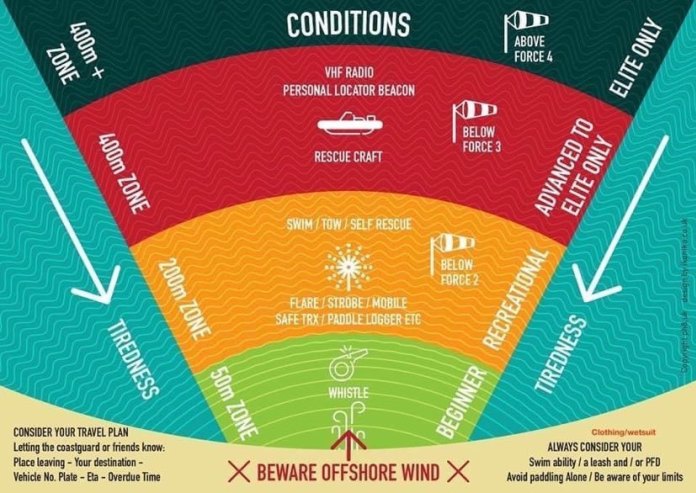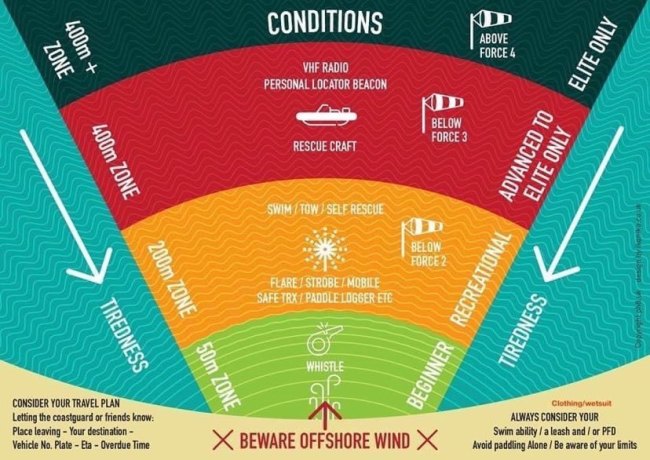 “Water Safety Escalator” created by David Tidball and Jim @lkonika to protect paddlers on the water from straying out too far.
“Water Safety Escalator” created by David Tidball and Jim @lkonika to protect paddlers on the water from straying out too far.Welcome to those early summer days where everyone is pressing to get out on the water. Whether you’re a veteran stand up paddler or a newbie, it’s important to remember the importance of paying attention to offshore winds. Easy to get blown off shore, not so easy to get back.
 David Tidball & his graphic designer Jim @ikonika created this informative tool for assessing your SUP safety when paddling offshore. There is no set formula for safety, but we hope this gives you some guidelines to keep it real.
David Tidball & his graphic designer Jim @ikonika created this informative tool for assessing your SUP safety when paddling offshore. There is no set formula for safety, but we hope this gives you some guidelines to keep it real.
Offshore Winds can Blow You Away!
The above graphic, created by David Tidball, a lifeguard trainer and Water Safety Manager in the U.K. gives some perspective on ability level & the distance you might venture from shore. Conditions change in a heartbeat. A general rule of thumb is never paddler further from shore than you have the ability to swim back if you lose your board. ALWAYS wear your PFD and carry a whistle unless you are in the surf zone. Use this as a guide to help you stay safe on those offshore days.
June’s Winds are Tricky: Stay Alert
June is traditionally a month where individuals piloting personal watercraft get into trouble. It is the initial return to the water after months of inactivity for some, the winds are predominantly offshore, the sun feels good and suddenly people find themselves farther from shore than they anticipated.
David Tidball is a lifeguard trainer assessor and a Water Safety Manager for SLSGB in the U.K. He is also a Coach Educator at British Canoeing and sits on their Safety Advisory Panel. As an instructor, he holds certifications from the ISA/BSUPA. In short, he’s educated, informed and trained in Water Safety procedures. So, when he made the above “Safety Escalator” with his graphic genius buddy, Jim @lkonika , developed according to the U.K. maritime law and safety service procedures, we decided to share it with you in support of paddlers coming back to the water. We want you all safe out there!
A common mistake for newbie paddlers is, when the wind is at their back, they don’t realize how quickly they may be getting blown from their starting point. Oftentimes, with the wind at your back, you don’t even feel it. Getting blown off shore is one thing, having the strength and stamina to paddle back is another.
3 Paddle Safe Tips for Paddling into Strong Wind
- Choke down on your paddle and take short, quick stroked. Think about getting the blade back into the water as fast as you can and bury the whole blade up to the shaft for maximum power.
- If the wind is too strong for you to stand and paddle, GET ON YOUR KNEES. When we are on our knees in choppy water, we are much more stable and less likely to get knocked off our stand up paddle boards. Remember to choke down on the paddle – as in move your hands away from the T-Top – and grip the paddle shaft in both hands closer to the blade and water. This will give you greater leverage when navigating chop and wind. Refer to Tip #1.
- If being on your knees doesn’t allow you to make headway into the wind, LAY DOWN on your BOARD and PADDLE it like a SURFBOARD. The lower on the board you are, the less wind resistance you provide. Lay flat on your stomach on your board, tuck the paddle underneath your body, and use your arms to paddle towards shore.
REMEMBER: A universal sign of distress is to wave the blade-side of your paddle up in the air from side-to-side. Always wear your PFD and carry a whistle. Stay SAFE and be visible out there!!!
Original Post from this site
